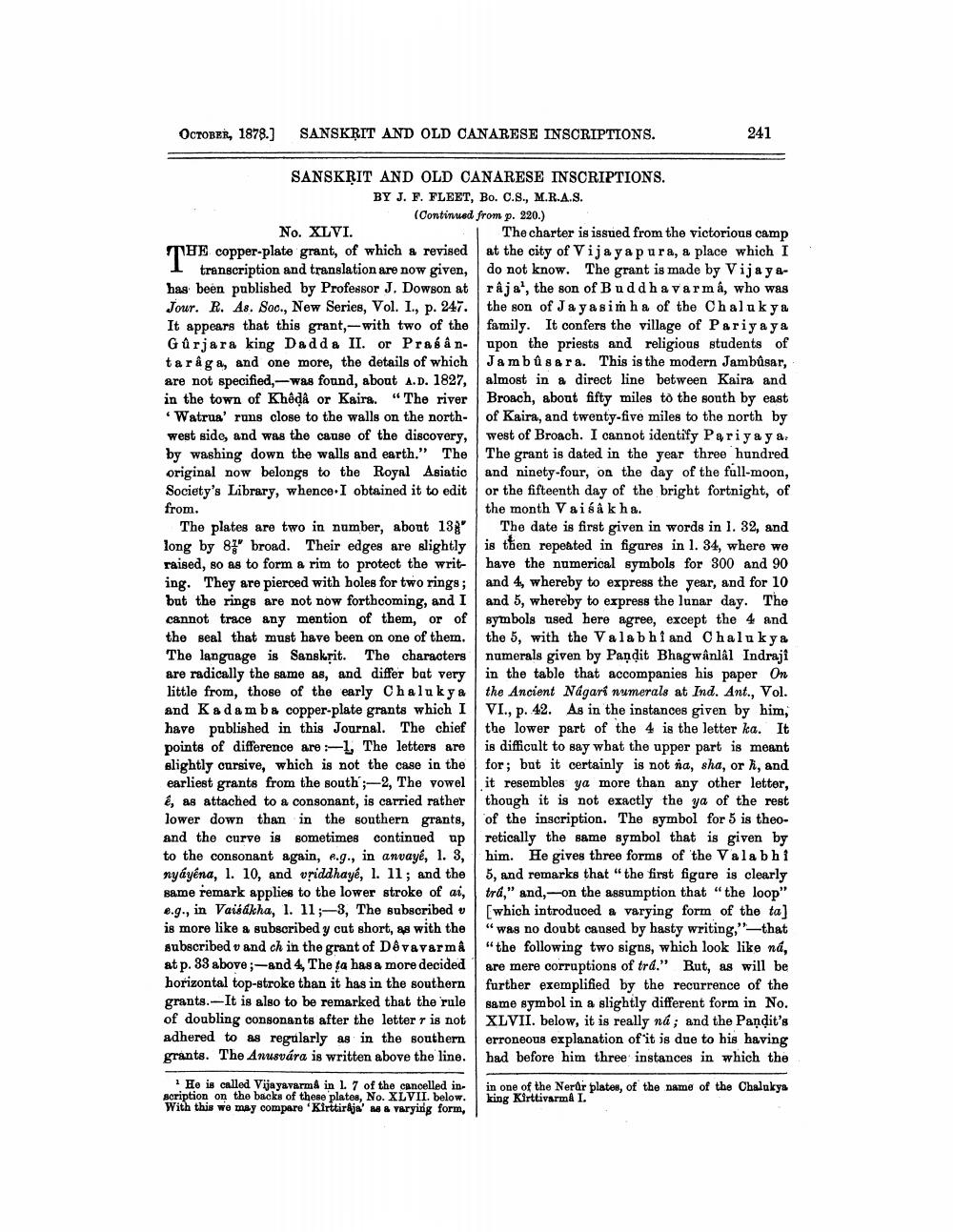________________
OCTOBER, 1878.)
SANSKRIT AND OLD CANARESE INSCRIPTIONS.
241
from.
SANSKRIT AND OLD CANARESE INSCRIPTIONS.
BY J. F. FLEET, Bo. C.S., M.R.A.S.
(Continued from p. 220.) No. XLVI.
The charter is issued from the victorious camp THE copper-plate grant, of which & revised at the city of Vijayapura, a place which I
1 transcription and translation are now given, do not know. The grant is made by Vijayahas been published by Professor J. Dowson at râja', the son of Buddha varma, who was Jour. R. As. Soc., New Series, Vol. I, p. 247. the son of Jayasimha of the Chalu kya It appears that this grant,-with two of the family. It confers the village of Pariyaya Gûrjara king Dadda II. or Prasa n- upon the priests and religious students of tarága, and one more, the details of which Jambû sa ra. This is the modern Jambûsar, are not specified, --- was found, about A.D. 1827, almost in a direct line between Kaira and in the town of Khêdå or Kaira. “The river Broach, about fifty miles to the south by east
Watrual runs close to the walls on the north- of Kaira, and twenty-five miles to the north by west side, and was the cause of the discovery, west of Broach. I cannot identify Pariya ya. by washing down the walls and earth." The The grant is dated in the year three hundred original now belongs to the Royal Asiatic and ninety-four, on the day of the full-moon, Society's Library, whence. I obtained it to edit | or the fifteenth day of the bright fortnight, of
the month Vaisakha. The plates are two in number, about 133" The date is first given in words in 1. 32, and long by 87" broad. Their edges are slightly is then repeated in figures in l. 34, where we raised, so as to form a rim to protect the writ- have the numerical symbols for 300 and 90 ing. They are pierced with holes for two rings; and 4, whereby to express the year, and for 10 but the rings are not now forthcoming, and I and 5, whereby to express the lunar day. The cannot trace any mention of them, or of symbols used here agree, except the 4 and the seal that must have been on one of them. the 5, with the Valabh i and Chalu kya The language is Sanskrit. The characters numerals given by Pandit Bhagwanlal Indraji are radically the same as, and differ bat very in the table that accompanies his paper On little from, those of the early Chalukya the Ancient Nagari numerals at Ind. Ant., Vol. and Kadamba copper-plate grants which I VI., p. 42. As in the instances given by him, have published in this Journal. The chief the lower part of the 4 is the letter ka. It points of difference are:-1, The letters are is difficult to say what the upper part is meant slightly cursive, which is not the case in the for; but it certainly is not na, sha, or h, and earliest grants from the south' ;-2, The vowel it resembles ya more than any other letter, é, as attached to a consonant, is carried rather though it is not exactly the ya of the rest lower down than in the southern grants, of the inscription. The symbol for 5 is theoand the curve is sometimes continued ap retically the same symbol that is given by to the consonant again, e.g., in anvayé, 1. 3, him. He gives three forms of the Valabhi nyáyêna, 1. 10, and vriddhayé, l. 11; and the 5, and remarks that "the first figure is clearly same remark applies to the lower stroke of ai, trá," and, on the assumption that "the loop" e.g., in Vaisakha, 1. 11;—3, The subscribed [which introduced a varying form of the ta] is more like a subscribed y cut short, 49 with the "was no doubt caused by hasty writing,"—that subscribed v and ch in the grant of Devavarmà "the following two signs, which look like ná, at p. 83 above ;-and 4, The ta has a more decided are mere corruptions of trd.” But, as will be horizontal top-stroke than it has in the southern further exemplified by the recurrence of the grants.-It is also to be remarked that the rule same symbol in a slightly different form in No. of doubling consonants after the letter r is not XLVII. below, it is really ná; and the Pandit's adhered to as regularly as in the southern erroneous explanation of it is due to his having grants. The Anusvára is written above the line. had before him three instances in which the
1 He is called Vijayavarma in l. 7 of the cancelled in- scription on the backs of these plates, No. XLVII. below. With this we may compare 'Kirttirkja' as & varying form,
in one of the Nerdr plates, of the name of the Chalukys king Kirttivarmi I.




